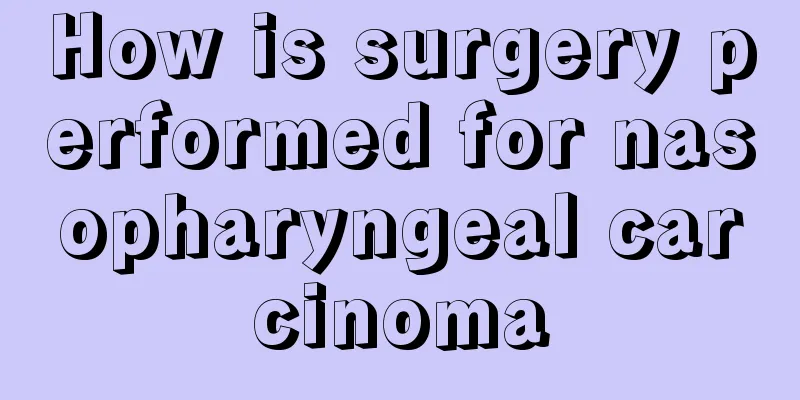How is surgery performed for nasopharyngeal carcinoma

|
Many patients are beginning to be familiar with nasopharyngeal carcinoma. We should choose the right treatment method, which is conducive to the treatment of nasopharyngeal carcinoma and puts patients at risk. The following small series introduces what is nasopharyngeal carcinoma surgery? Nasopharyngeal carcinoma is one of the most common tumors in China, with Guangdong, Guangxi, Hunan, Fujian and other provinces being one of the most common tumors in my country. The incidence rate in men is 2-3 times that in women, and the age group with the highest incidence rate is 40-50 years old. Surgical method for nasopharyngeal carcinoma: perform tracheotomy and intubation first, and then perform surgery under general anesthesia. Make a horseshoe-shaped incision along the inner side of the palatal tooth root 0.5 cm away from the alveolar ridge, cut the hard palate mucosa, peel it to the soft palate part under the mucosa, and remove some hard palate plates and vomers. Make a transverse cut on the nasal floor mucosa at the junction of the hard and soft palate to expose the top wall of the nasopharyngeal cavity, the anterior part of the walls on both sides, and the tumor. At the posterior edge of the nasal septum and the upper edge of the posterior nasal opening, cut the nasopharyngeal mucosa directly to the bone surface, perform blunt or sharp separation, cut along the junction of the nasopharyngeal top, and cross-cut the mucosa down to the junction of the oropharynx and the posterior wall of the nasopharynx, and remove the entire posterior nasopharyngeal top mucosa together with the tumor. Surgical treatment is suitable for: The pathological type is well-differentiated squamous adenocarcinoma or adenocarcinoma, as well as other cancers that are insensitive to radiation. The lesions are limited to the top wall, posterior wall or anterior wall. If there are no contraindications to surgery, resection of the primary lesion can be considered. All patients in II, III, and IV are not suitable for surgery. If there are residual or recurrent lesions in the nasopharynx or neck after radiotherapy, such as those limited to the posterior or anterior wall of the nasopharyngeal roof, without skull base bone damage, and in generally good condition, and radiotherapy is not suitable in the near future, resection of the lesion may be considered. When there is residual or recurrent disease in the neck, active patients may consider neck lymph node dissection if the extent is limited. |
<<: What are the signs of bladder cancer recurrence
>>: How to diagnose breast cancer bone metastasis
Recommend
Causes of constipation in one-year-old babies
A normal person has bowel movements once or twice...
The efficacy and contraindications of drinking licorice tablets soaked in water
Licorice tablets are a common Chinese patent medi...
Symptoms of kidney deficiency and dampness
There are many technical terms in traditional Chi...
What causes coughing and bleeding? These diseases are the most common
If you cough in the middle of the night and have ...
How to quickly soak sea cucumber
Sea cucumber is not only a very precious food ing...
How to peel grapes
Grapes are a very delicious fruit in our life. Th...
Tips to make your hair grow faster
Some people have poor hair quality, often with dr...
What can I use to wash my hands to kill the bacteria on my hands
There are a lot of bacteria on people's hands...
What's the matter with blood in urine
Blood in urine is what we hear in TV commercials,...
Introduction to methods of removing scale
Everyone knows that when a teapot is used to boil...
What is the best calcium supplement? What is the best calcium supplement?
Calcium is an essential element for the human bod...
Do I need to replenish water if I have red blood streaks?
Red blood streaks are a skin problem that many pe...
Will I get fat if I quit smoking?
Nowadays, many people are addicted to smoking. Bu...
There is a hard lump on my eyebrow that hurts
It is not uncommon for a hard and painful lump to...
Will gallbladder removal cause bile duct stones?
Bile duct stones are very common and are a type o...









